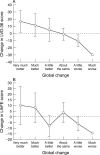The left ventricular dysfunction questionnaire (LVD-36): reliability, validity, and responsiveness
- PMID: 10814618
- PMCID: PMC1760861
- DOI: 10.1136/heart.83.6.634
The left ventricular dysfunction questionnaire (LVD-36): reliability, validity, and responsiveness
Abstract
Objective: To examine the reliability, validity, and responsiveness of a new health status measure (LVD-36) for patients with left ventricular dysfunction which was designed with emphasis on content validity, clarity, brevity, and ease of use.
Design: At baseline, patients completed the LVD-36 and a range of measures reflecting general health and disease severity. The LVD-36 was repeated after one week. After six months, it was repeated again, along with a transition question to measure global changes in health.
Setting: Patients were recruited from the cardiology and general medical clinics at a south west London hospital.
Patients: 60 patients with chronic left ventricular dysfunction.
Interventions: None.
Main outcome measures: Short form 36 questionnaire (SF-36), Minnesota living with heart failure questionnaire (LIhFE), New York Heart Association criteria, and exercise performance and echocardiographic tests.
Results: The LVD-36 showed good internal consistency (kappa = 0.95) and repeatability (r(i) = 0.95). Its scores were significantly associated with SF-36 mental and physical component scores (r = -0. 48 and -0.75; p < 0.0001), with exercise capacity (r = -0.52; p < 0. 0001), and with systolic shortening fraction (r = -0.27; p < 0.05). Change in the LVD-36 over six months was associated with change in overall health (F = 5.7; p < 0.001). In tests of validity and responsiveness, the LVD-36 performed similarly to or marginally better than the LIhFE.
Conclusions: The LVD-36 showed a high level of reliability and validity, and appears to measure changes in health. It provides a short, simple, valid, and reliable measure of health status in patients with left ventricular dysfunction.
Figures
References
Publication types
MeSH terms
LinkOut - more resources
Full Text Sources


